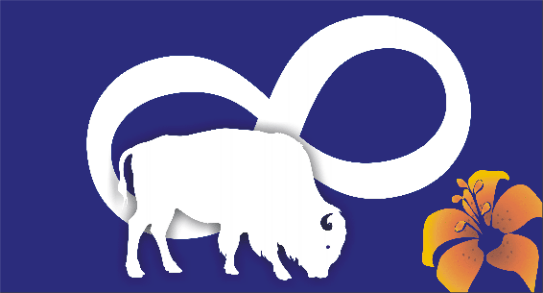Who are the Métis?
In Canada the term 'Métis' indicates a person of mixed Indigenous and European ancestry. Métis comes from the Latin word miscere and misticius meaning 'to mix' and 'mixed race'. The word itself is French – the literal translation meaning 'half-breed'. The term half-breed was used until the 1930s, now it is considered offensive. The term Métis is used extensively instead of the term half-breed.(1) Other words were used in the past to refer to the Métis: 'bois-brûlé' (burnt wood because of their dark complexion), 'wissakodewinmi' (Ojibwa word for 'half-burnt woodmen'), 'michif' (also a Métis language), 'country born' and others. (1)
Louis Riel had this to say about the Métis and the word itself:
"The Métis have as parental ancestors the former employees of the Hudson’s Bay and Northwest Fur Companies and as their maternal ancestors Indian women of various tribes. The French word, 'Métis', is derived from the Latin participle mixtus, which means 'mele'; it expresses well the idea that is sought to be conveyed. However, appropriate the corresponding English expression 'Halfbreed' might have been for the first generation of the mixture of blood, now that European blood and Indian blood are mixed in every degree, it is no longer generally applicable. The French word 'Métis' expresses the idea of the mixture in the most satisfactory manner possible, and thus becomes suitable name for our race. Why should we care to what degree exactly of mixture we possess European blood and Indian blood?” (Goulet & Goulet, 2008, p.14)
Métis peoples make up 1.7% of the Canadian population and according to the 2016 Household census, there are Métis in every province and territory of Canada. In Saskatchewan, they make up 5.4% of the population. Only Manitoba has a higher Métis population at 7.2%.(2) Métis identity, specifically who can call themselves Métis, is a contentious issue and not something that will be discussed in this module. Rather, the focus of this module is to present a broad overview of the Métis, the history and current state of Métis land.

Above: Métis Nation flag, image from http://www.crwflags.com/fotw/flags/ca_mn_sk.html
The Métis Flag above is the flag for the Métis Nation of Saskatchewan. The infinity symbol is to indicate the joining of two cultures and the existence of a people forever. The buffalo is to acknowledge the history of how important the buffalo and buffalo hunt were to the Métis as a people, as well as the spiritual significance of the white buffalo. The prairie lily, being the provincial flower of Saskatchewan, is to show that Saskatchewan is part of the Métis homeland.
The following video showcases some stories of what growing up Métis was like.
< Chapter 8 Table of Contents Chapter 10 >
(1) Goulet, G., & Goulet, T. (2008). The Metis: Memorable Events and Memorable Personalities. Calgary, AB: FabJob Inc.
(2) Saskatchewan Bureau of Statistics. (2016). Saskatchewan Aboriginal Peoples: 2016 Census. Retrieved from: http://publications.gov.sk.ca/documents/15/104388-2016%20Census%20Aboriginal.pdf